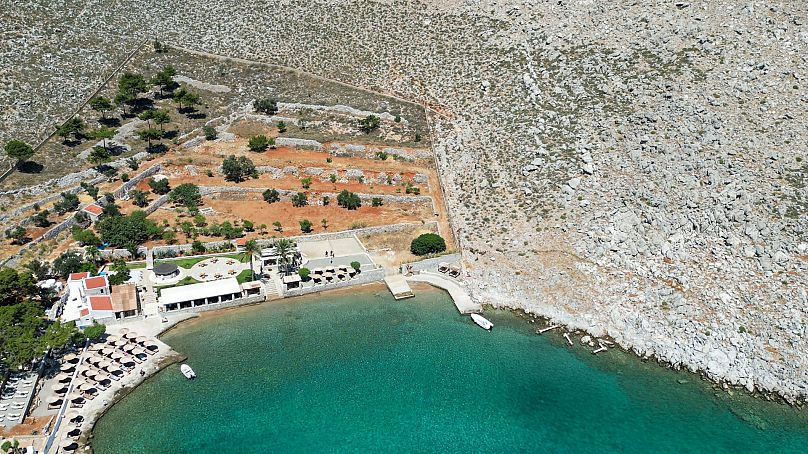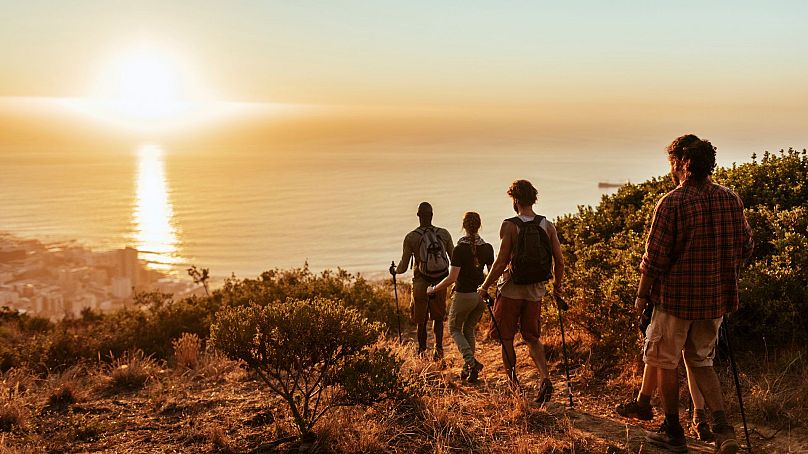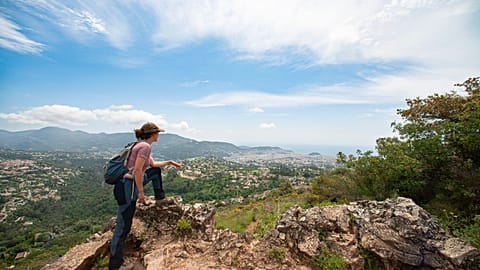Extreme heat kills more than 175,000 people a year in Europe - here's how to stay safe when travelling in a heatwave.
Europe's scorching hot summer is showing no signs of cooling down, with Italy facing its warmest weekend of the year so far and heatwave warnings issued in southern France.
It's causing more than just discomfort: a recent report from the World Health Organization (WHO) revealed that extreme heat is killing more than 175,000 people a year in Europe.
In June, this was laid bare when British TV presenter and health guru Michael Mosley, as well as four other tourists, died while hiking in Greece’s historic early heatwave.
As temperatures soar above 40C from Italy to Spain, prompting extreme weather warnings and sparking wildfires, Euronews Travel asks health and hiking experts how to stay safe while walking in high temperatures.
Opt for cooler destinations or months
In June, a 74-year-old Dutch tourist who was found dead on the eastern Greek island of Samos after going for a walk; the following day, a 55-year-old American tourist’s body was found on the Greek island of Mathraki, west of Corfu.
Earlier that month on the island of Crete, a Dutch tourist, aged 67, and a French tourist, 70, both died while walking in the extreme heat.
With Europe’s changing weather patterns, even tour companies themselves are having to adapt.
“We can no longer hike in some countries from June to September as the heat starts earlier - for example Spain is sometimes 40 degrees in June,” says a spokesperson from female-led activity holiday specialist WalkingWomen.
They have adapted their programmes to do more hiking in spring, autumn and winter when temperatures are lower. During the summer months, they go north to Scotland and Norway where it is cooler for hiking.
Similarly, small group adventure travel company Intrepid Travel is adjusting to new weather extremes.
“At Intrepid, we’ve definitely seen an increase in the severity and frequency of extreme weather events in Europe,” says Radek Nowak, an active product manager for Intrepid. Last year, the company recorded 121 more climate-related incidents globally than the year before in its operational reports.
“We’ve had to change and adapt to this new reality by extending departures into shoulder season months… and considering climate change when investing in future travel destinations - like expanding in Scandinavia,” Nowak continues.
The company no longer runs hiking trips in Spain, Türkiye and Portugal during the hottest months of July and August, and has added more trips in April and October to make it easier for people to avoid the extreme temperatures.
It has also added winter trips and departures to places like Greece, Croatia, Spain and Italy.
Be prepared to adjust your itinerary
If you are unable to change your travel dates or destination, be prepared to adapt your plans each day in line with the weather.
“We’ve had to adjust existing itineraries to ensure outdoor activities don’t fall into the hottest part of the day,” says Nowak.
Check local weather forecasts and save your hikes for early mornings and evenings to avoid strenuous activity in peak temperatures.
Spend the middle of the day doing indoor activities like museums, galleries and shopping - or do as the locals do and take a siesta.
Plan your hiking route and rest stops
Planning ahead extends to knowing where you’re going to walk. Local rescue teams in Greece told media that tourists often veer off track to see sites and get lost. This puts walkers in danger and makes rescue missions more difficult.
“Not having a good idea of the length or terrain of the walk can be a risk,” agrees Nowak. “Map out rest stops before you go,” he suggests. “In very hot weather, I’d advise people not to go alone - if possible walk with a friend or a local tour guide. If you are going alone, make sure someone knows where you’re heading and when you’ll be back.
“It’s also good to check if you will have phone reception on your walk, in case you need to contact someone and ask for help.”
Remember that both trees and water provide a natural form of air-conditioning that will make your walk safer and more comfortable. “Walk on shady routes - ideally near water,” WalkingWomen recommends.
Drink less alcohol, eat more fruit
Always carry a supply of water with you when hiking, and refill your reusable bottle at every opportunity.
“It’s vital that you stay hydrated when the sun is so strong, and make a conscious effort to drink even more water than usual. About three litres a day will keep you hydrated,” says Huw Owen, co-founder of tailor-made tour operator TravelLocal.
You should also minimise alcohol consumption, especially on the night before a long walk and during the day, as it can dehydrate you further.
Eating plenty of foods with high water content like fruit and salads can help you stay hydrated, while snacks and regular small meals throughout the day help to keep your energy levels up.
What to wear for hiking in hot weather
Loose fitting, light coloured clothing in natural materials will help keep you cool while hiking.
Wear sunglasses, long sleeves, plenty of high SPF sunscreen to protect your eyes and skin from the sun’s rays. A hat - ideally with a wide brim - is also essential.
“Yesterday we saw a couple [of foreigners] walking a trail in 41C without hats. It defies logic,” Dimitris Kalatzis, who heads up the Samos rescue team in Greece, told local media earlier this week.
An umbrella can also offer shade, while a sarong can double as a cover-up, picnic blanket, or can be soaked with water to provide relief from the heat.
Know the signs of heatstroke and exhaustion
It’s important to know the signs of heatstroke and heat exhaustion so you can act quickly if you or one of your hiking companions experience them.
Weakness, dizziness, increased sweating, headache, irritability, confusion, nausea and a rapid heartbeat can all signal that your body is struggling to cope. If you face any of these symptoms, you should find shade, drink water, and seek medical attention if necessary. If possible, take a cool shower or apply cold towels to the skin.




















